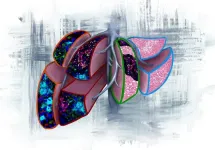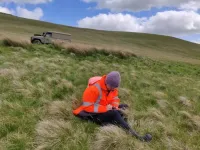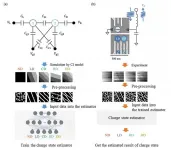(Press-News.org) Researchers at Weill Cornell Medicine with an international team have used liver biopsies to identify cellular and molecular markers that can potentially be used to predict whether and when pancreatic cancer will spread to an individual’s liver or elsewhere, such as the lung.
The study, published on June 28 in Nature Medicine, proposes that information from a liver biopsy—a small tissue sample collected for lab analysis—when pancreatic cancer is diagnosed may help guide doctors in personalizing treatment, such as liver-directed immunotherapies, before cancer cells have the chance to metastasize.
Only 10 percent of people with pancreatic cancer will survive more than two years after initial diagnosis. “If we can predict the timing and location of metastases, that could be a real game changer in treating pancreatic cancer, particularly patients at high metastatic risk,” said study co-senior author Dr. David Lyden, the Stavros S. Niarchos Professor in Pediatric Cardiology and professor of pediatrics and of cell and developmental biology at Weill Cornell Medicine.
In 2015, Dr. Lyden and his colleagues discovered that pancreatic cancer cells secrete factors that reach distant organs, most often the liver, to establish a pre-metastatic niche for new tumors to form.
To find out how these alterations prime their new location for cancerous colonization, Dr. Lyden collaborated with lead author Dr. Linda Bojmar, an adjunct assistant professor of molecular biology research in pediatrics at Weill Cornell Medicine and assistant professor of clinical and experimental medicine at Linköping University in Sweden.
Together with researchers at Memorial Sloan Kettering Cancer Center, including co-senior author Dr. William Jarnagin, co-first authors Drs. Constantinos Zambirinis and Jonathan Hernandez, and the hepatopancreatobiliary team, they obtained liver biopsies from 49 individuals who underwent surgical treatment for early-stage pancreatic cancer. They also collected liver biopsies from 19 people who underwent a similar operation for conditions unrelated to cancer, for example, removal of benign pancreatic cysts.
Liver Biopsies Reveal Early Signs of Rapid Metastasis
The researchers then conducted a battery of molecular, cellular and metabolic analyses on these samples to determine whether they could identify hallmarks that preceded—or potentially prevented—subsequent metastases in the patients. They found that the livers of recurrence-free survivors, who showed no signs of cancer spread after a follow-up period of at least three years, looked much like the livers of people who never had cancer.
At the other end of the spectrum were those who developed liver metastases within six months of diagnosis—a patient group that has poor prognosis with limited therapeutic options. Their livers were riddled with so-called neutrophil extracellular traps (NETs), dense tangles of DNA and enzymes released by dying neutrophils, immune cells that are a first line of defense against infection. Because these NETs are strongly associated with future metastases and develop so early in the course of disease, radiological imaging in the near future may be able to detect them and identify patients in danger of this aggressive spread.
“These individuals could then receive a full course of chemotherapy or, if the metastases are detected when only a few appear, perhaps the secondary tumors could be surgically removed,” said Dr. Lyden, who is also a member of the Sandra and Edward Meyer Cancer Center and the Gale and Ira Drukier Insitute for Children’s Health at Weill Cornell Medicine. In addition, he and his colleagues are investigating whether drugs that digest the DNA which forms the NETs could prevent liver metastases.
Immune Responses in Later Metastases
The researchers identified two other categories of patients in the study: those who would go on to develop later metastases to the liver and those who would have the cancer spread to other sites, such as the lung. Patients whose cancers spread to organs other than the liver, showed a strong immune response fighting the cancer—protective T cells and natural killer cells had infiltrated their livers, and many immune-regulatory genes were activated. These individuals who are prone to developing metastases outside the liver may benefit from immunotherapy to boost their ongoing anti-tumor immune response.
On the flip side, those whose livers succumbed to later metastases also accumulated immune cells—but the cells showed signs of metabolic exhaustion. “It’s as if the liver was trying to protect itself, but lost the battle in the end,” said Dr. Bojmar.
The researchers plan to validate their findings in a larger cohort of patients with pancreatic cancer and examine if this approach could be useful with other newly diagnosed cancers. “We hope to develop a tool for predicting which patients with colorectal cancer will go on to develop liver metastases based on the cellular, molecular and metabolic profiles of their liver biopsies,” said co-senior author Dr. Robert Schwartz, associate professor of medicine at Weill Cornell Medicine.
Authors from multiple institutes throughout the United States and in Sweden and Israel contributed to this study.
Many Weill Cornell Medicine physicians and scientists maintain relationships and collaborate with external organizations to foster scientific innovation and provide expert guidance. The institution makes these disclosures public to ensure transparency. For this information, please see profile for Dr. David Lyden.
This work was supported in part by: National Cancer Institute grants CA224175, CA210240, CA232093, CA163117, CA207983, CA163120, CA169416, CA169538, CA218513 and the National Institute of Allergy & Infectious Diseases grant AI144301; the United States Department of Defense grants W81XWH-13-1-0425, W81XWH-13-1-0427, W81XWH-13-1-0249, W81XWH-14-1-0199 and W81XWH-21-1-0978; the National Institutes of Health/National Center for Advancing Translational Sciences grant UL1TR002384; and the National Institutes of Health grants R01CA234614 and R01DK121072.
END
New predictors of metastasis in patients with early-stage pancreatic cancer
2024-06-28
ELSE PRESS RELEASES FROM THIS DATE:
Climate change to shift tropical rains northward
2024-06-28
A study led by a UC Riverside atmospheric scientist predicts that unchecked carbon emissions will force tropical rains to shift northward in the coming decades, which would profoundly impact agriculture and economies near the Earth's equator.
The northward rain shift would be caused by complex changes in the atmosphere spurred by carbon emissions that influence the formation of the intertropical convergence zones. Those zones are essentially atmospheric engines that drive about a third of the world’s precipitation, Liu and his co-authors report in a paper published Friday, June 28, in the journal Nature Climate Change.
Tropical ...
City of Hope study suggests changing the gut microbiome improves health outcomes for people newly diagnosed with metastatic kidney cancer
2024-06-28
LOS ANGELES — Physician scientists from City of Hope, one of the largest cancer research and treatment organizations in the United States, found that people with metastatic kidney cancer who orally took a live biotherapeutic product called CBM588 while in treatment with immunotherapy and enzymatic tyrosine kinase inhibitors experienced improved health outcomes. The phase 1 trial was published today in Nature Medicine.
Microorganisms in the gut modulate the immune system. City of Hope researchers are now in discussions with the global SWOG Cancer ...
Surprising meteorite impact rate on Mars can act as ‘cosmic clock’
2024-06-28
Seismic signals have suggested Mars gets hit by around 300 basketball-sized meteorites every year, providing a new tool for dating planetary surfaces.
The new research, led by scientists at Imperial College London and ETH Zurich working as part of NASA's InSight mission, has shed light on how often ‘marsquakes’ caused by meteorite impacts occur on Mars.
The researchers found that Mars experiences around 280 to 360 meteorite impacts every year that produce craters larger than eight metres in diameter and shake the red planet’s ...
Air pollution exposure during childhood linked directly to adult bronchitis symptoms in new research
2024-06-28
A new study brings fresh revelations about the connection between early-life exposure to air pollution and lung health later in life. A research team led by the Keck School of Medicine of USC has shown that exposure to air pollution during childhood is directly associated with bronchitis symptoms as an adult.
To date, many investigations in the field have established intuitive links that are less direct than that: Air pollution exposure while young is consistently associated with lung problems during childhood — and childhood lung problems are consistently associated with lung issues as an adult.
The current study, published in the American Journal of Respiratory ...
Kids given ‘digital pacifiers’ to calm tantrums fail to learn how to regulate emotions, study finds
2024-06-28
Children learn much about self-regulation – that is affective, mental, and behavioral responses to certain situations – during their first few years of life. Some of these behaviors are about children’s ability to choose a deliberate response over an automatic one. This is known as effortful control, which is learned from the environment, first and foremost through children’s relationship with their parents.
In recent years, giving children digital devices to control their responses to emotions, especially if they’re negative, has ...
No evidence that England’s new ‘biodiversity boost’ planning policy will help birds or butterflies
2024-06-28
A new legal requirement for developers to demonstrate a biodiversity boost in planning applications could make a more meaningful impact on nature recovery if improvements are made to the way nature’s value is calculated, say researchers at the University of Cambridge.
From 2024, the UK’s Environment Act requires planning applications to demonstrate an overall biodiversity net gain of at least 10% as calculated using a new statutory biodiversity metric.
The researchers trialled the metric by using it to calculate the biodiversity value of 24 sites across England. These sites have all been monitored over the long-term, allowing the team to compare biodiversity ...
Visual explanations of machine learning models to estimate charge states in quantum dots
2024-06-28
A group of researchers has successfully demonstrated automatic charge state recognition in quantum dot devices using machine learning techniques, representing a significant step towards automating the preparation and tuning of quantum bits (qubits) for quantum information processing.
Semiconductor qubits use semiconductor materials to create quantum bits. These materials are common in traditional electronics, making them integrable with conventional semiconductor technology. This compatibility is why scientists consider them strong candidates for future ...
The future of metals research with artificial intelligence
2024-06-28
A research team led by Professor Hyoung Seop Kim from the Graduate Institute of Ferrous & Eco Materials Technology and the Department of Materials Science and Engineering and Jeong Ah Lee, a PhD candidate, from the Department of Materials Science and Engineering, in recent collaboration with Professor Figueiredo from Universidade Federal de Minas Gerais's Department of Metallurgical and Materials Engineering in Brazil, has developed an optimal artificial intelligence model to predict the yield strength of various metals, effectively addressing traditional cost and time limitations. This research has been published in the online edition of Acta Materialia, an ...
Tissue bridges are reliable predictors of recovery from cervical spine injuries
2024-06-28
The results of the longitudinal study “Prognostic value of tissue bridges in cervical spinal cord injury” have the potential to change clinical practice. They have just been published in The Lancet Neurology, the world’s leading journal of clinical neurology. The team led by lead author Dr. Dario Pfyffer and senior author Prof. Dr. med. Patrick Freund from Balgrist University Hospital and the University of Zurich, which includes SCI experts from around the world, has successfully developed models that incorporate tissue bridges in the spinal cord in a large, multicenter cohort of patients with cervical SCI for improved prognosis of clinical outcomes. These ...
Junior rank, male sex, younger age strongly linked to ‘harmful gambling’ among UK military
2024-06-28
Several indicative factors, including junior rank, male sex, and younger age, are strongly linked to ‘harmful gambling’ among serving UK military personnel, finds an analysis of survey responses, published online in the journal BMJ Military Health.
Harmful gambling refers to the toll taken on finances, health, personal relationships, and work: nearly 1 in 4 respondents reported one or other of these effects over the past year.
The findings prompt the researchers to call for the prioritisation of better, earlier, and targeted support to stave off the harmful consequences of ...








